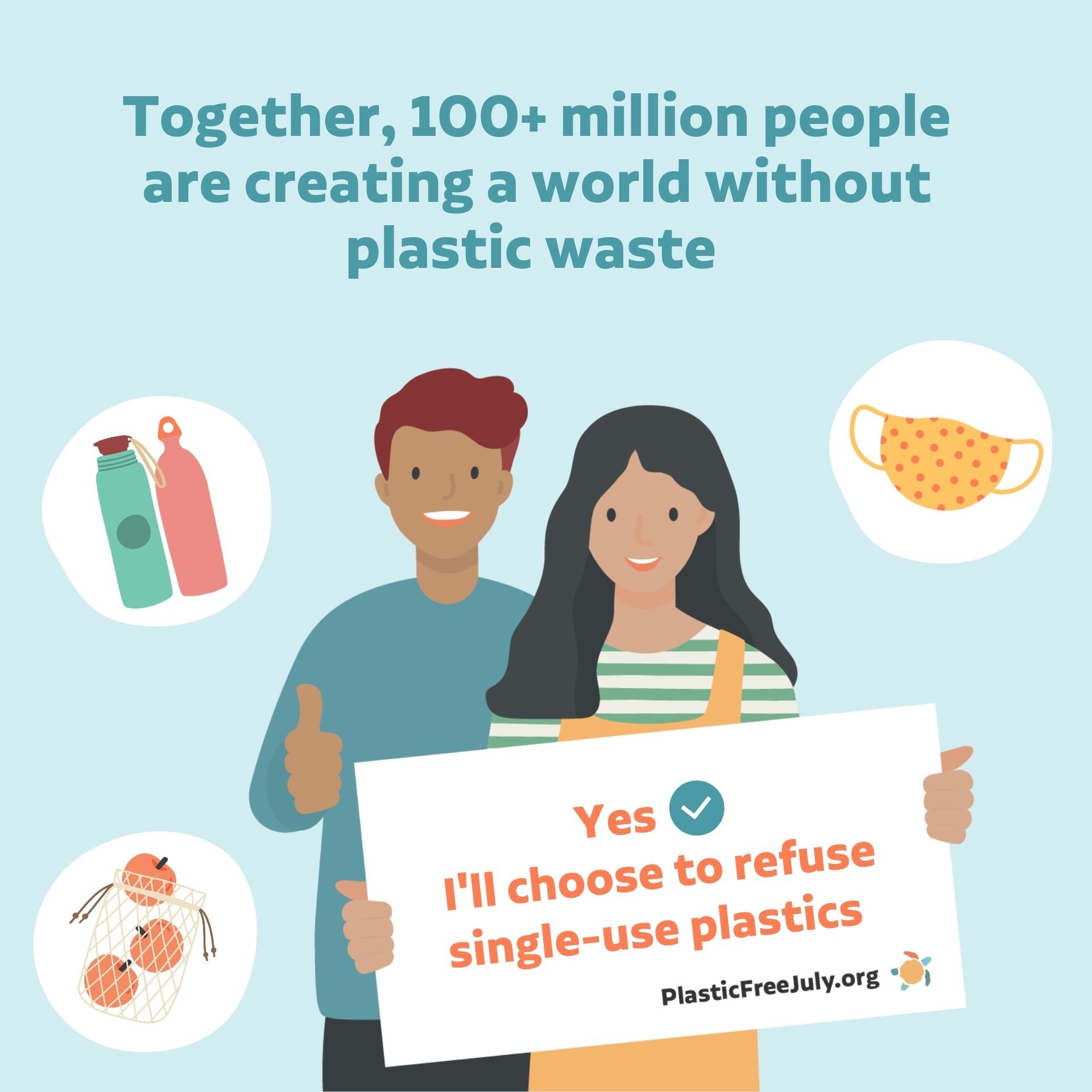Reduce single-use plastic: Plastic Free July
Plastic Free July is a global campaign which has been running since 2011. It encourages people to reduce their plastic consumption for an entire month.
The website is packed full of ideas for small lifestyle changes. And the campaign challenges us to pick one single-use plastic to avoid during the month. If you want to pick more, that’s ok too.
Why is Plastic Free July so important?
The environmental charity, Surfers Against Sewage, report that “12 million tonnes of plastic are pouring into the ocean every year. Plastic has been found in the deepest parts of the ocean, as far away as the Antarctic and across UK’s beaches.”
Plastic can be found in all kinds of products. The obvious ones are bags and bottles. But it also appears in clothes, and even teabags.
The production of new plastics comes from oil and gas, making it a high carbon emitter. And plastics take years to breakdown. Just take a look at this infographic from WWF.
It’s staggering to think that a plastic water bottle, used for one drink, will take 450 years to break down.
The way plastics break down means that microplastics (tiny plastics smaller than 5mm) are now in our food chain. Other products such as cosmetics, or even synthetic clothes, also create microplastics. These tiny particles enter our rivers, soils and oceans. And they’re subsequently found in the food and drink we consume.
You may have heard about the Great Pacific Garbage Patch. These garbage patches are are almost entirely microplastics.
Animals mistake plastic for food. According to Keep Britain Tidy, scientists recently found that 100% of animal washed up on British shores had plastic in their stomach. Plastic also pollutes our countryside, waterways and motorways.
How to get started on Plastic Free July
Reducing the production and consumption of single-use plastics will go a long way to solving the crisis. But where you start will depend on what you already do and how much you want to challenge yourself.
Check the ideas below to get going on your Plastic Free July challenge.
Quick switches
Take reusable canvas shopping bags to the shops rather than buying plastic bags at the till.
Refuse plastic straws if offered with your drink. Even better, bring your own reusable straw.
Choose cans of fizzy drinks instead of plastic bottles. This blog post written by Professors from the University of Southampton gives an overview of the environmental impact of different soft drink containers.
Make sure cotton buds are made with cardboard not plastic.
Use a refillable water bottle instead of buying plastic bottles of water.
Take a reusable coffee cup to the cafe for your takeout.
Use reusable containers with lids for leftover food instead of buying cling film.
Use the packaging you already have (eg. if you have takeaway containers which can be reused for leftover food).
Wash clothing containing polyester in bags. This will help to avoid plastic microfibres being discharged into the water system.
Avoid cling film with reusable silicon tops for food containers.
Medium effort or expense
Make sandwiches or salad at home to avoid buying pre-packed lunch items.
Make sure your picnic or camping utensils are reusable.
Use plastic free envelopes for mailing items.
Take reusable containers to the supermarket, refill store or butchers.
Use bamboo golf tees instead of plastic.
Find a local refill store for items like washing up liquid, hand soap, shower gel, shampoo and conditioner.
Buy loose produce (not pre-packed) from supermarkets. Even better if you have a small, local greengrocer or farmer’s market.
Use compostable bin liners.
Shop at pre-loved clothing stores.
Switch to plastic free teabags. Paper teabags are often sealed with plastic glue. Others are made out of plastic, leaking microplastics into your tea.
Longer-term changes
Buy an eco-friendly toothbrush (eg. from bamboo) or look for recyclable brands.
Make home-made snacks instead of buying takeaway items.
Buy toilet roll in bulk <- [affiliate link] from an eco-friendly supplier. Toilet roll is delivered in cardboard boxes rather than wrapped in plastic.
Check online retailers are using sustainable packaging before purchasing.
Look for sustainable and ethically produced clothing.
Make your own eco-friendly party decorations.
Watch for polyester (plastic) in clothing. Look for natural fibres such as Hemp and linen.
Repair clothing rather than throwing away. If you want a technical repair for outdoor kit, check the following:
Patagonia Repairs (not personally used)
Lancashire Sport Repairs (not personally used)
Activewear often contains polyester. But if there are no alternatives, look for recycled polyester options.
Arrange a local litter pick.
Next steps
Making changes with the ideas above (30 in total) is a great way to begin reducing plastic consumption.
However, if you’re really struggling to know where to start, the Plastic Free July website has a Pesky Plastics Quiz Tool. This will help you find the plastics which sneak into your shopping bag without realising!
I’m always on the lookout for ideas so if you have any fab switches, drop a comment below.

